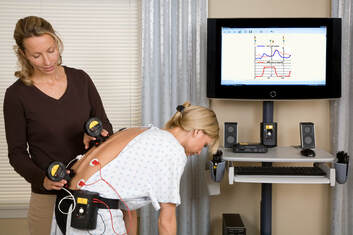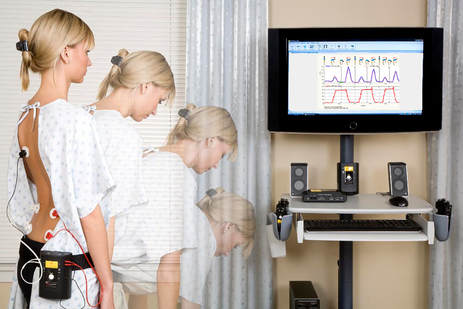|
Schedule your client's DynaROM exam below. If you have any questions, please contact us.
Are you a patient receiving a dynaROM exam? here's what you need to know before you go. |
What is the DynaROM?

Clinicians have long searched for a test that would "measure pain." X-Rays can show broken bones and arthritis and MRIs can show torn muscles, ligaments and other soft tissue problems, but these tests do not identify pain. The DynaROM is a functional test that simultaneously measures spine motion and muscle activity. Muscles contract when we move, but they also contract when we experience pain. The DynaROM can measure muscle activity - not just when you are standing still, but also while bending, twisting or rotating the spine. The system collects data as a subject moves through a series of motions. The results provide your clinician with objective data about the quality of your spinal motion and your muscle activity. This data can be used to establish the presence or absence of injury, as well as track your response to treatment.
Learn more about the dynarom exam:
What is the dynarom exam?
DynaROM is used to test for pain as a result of soft issue injury from an auto accident or work injury. Sensors are placed on the body to measure both how far you can bend and your muscle guarding response. You are required to perform various motions as the sensors graph these measures. This data is used to aid in establishing need for care and tracking your progress over time.
What does the test involve?
The DynaROM Test is performed for both the lower back (lumbar) and the neck (cervical). This test is non-invasive and completely painless. You may be asked to change into a hospital gown to allow easier access to your back and neck. The test is conducted with your shoes off. You will also be asked to remove or turn off your cell phone or any other electronics you may have on you, as these devices may interfere with the electronic equipment used. A technician will attach electrodes to specific areas on the patients back and neck. You will be asked to bend and twist within your level of comfort while our system graphs your muscles firing in response to these movements and your range of motion.
How long does the test take?
The total test time can range from 45 - 60 minutes for both cervical and lumbar tests. This includes time for filling out a pain questionnaire and answering any questions you may have before or after the test is complete.
How do I prepare for the test?
12 HOURS PRIOR TO TESTING: Avoid using any pain medications, TENS machines and/or muscle relaxers.
24 HOURS PRIOR TO TESTING: Avoid any vigorous exercise for at least 24 hours.
You may resume all normal activity once the test is complete.
24 HOURS PRIOR TO TESTING: Avoid any vigorous exercise for at least 24 hours.
You may resume all normal activity once the test is complete.
When will I know my test results?
Once the test is complete, a thorough interpretation will be provided to your health care provider. Reports are usually available in 3-5 business days. Upon your follow-up visit, your referring healthcare provider can go over the results with you in detail.


